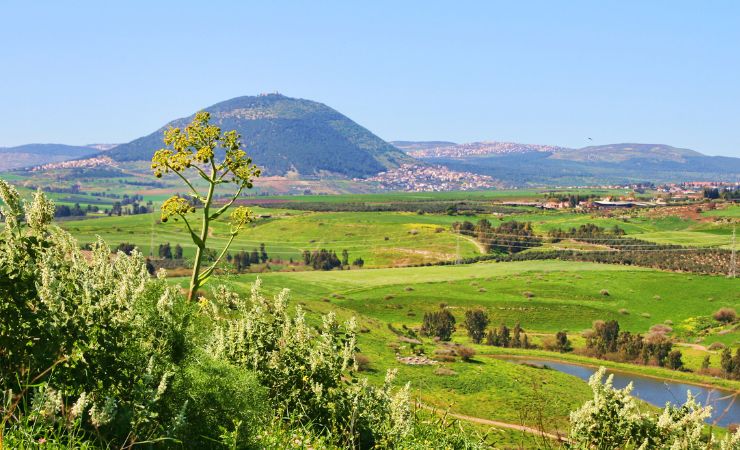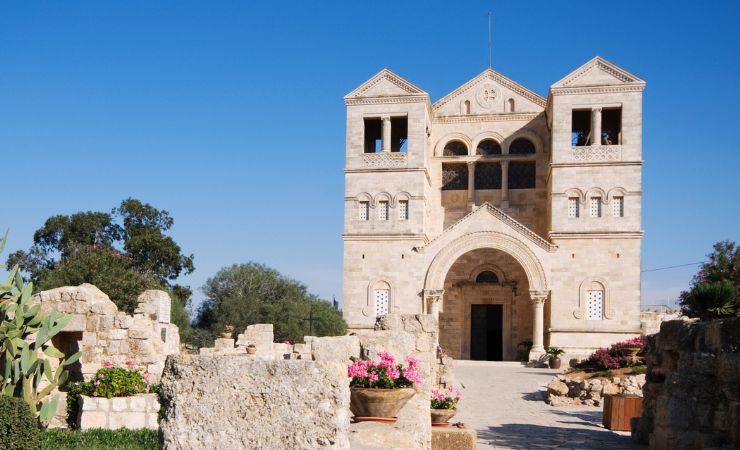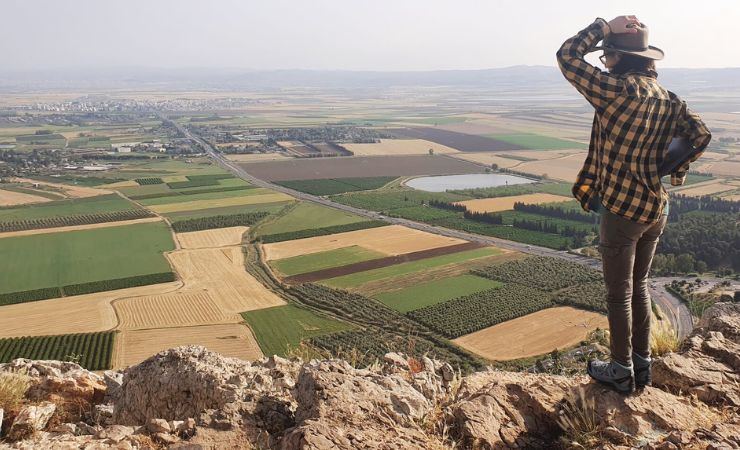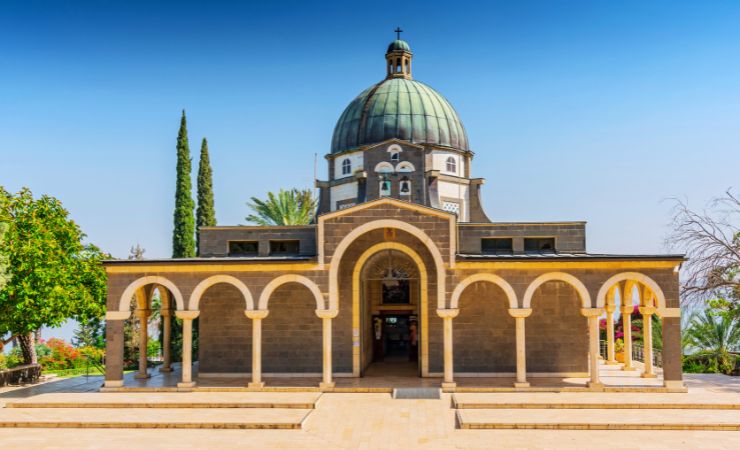Mount Tabor: Biblical Sites and Their Stories
Originally published: August 2023 | Last updated: May 2025
Mount Tabor, often referred to as the “Mount of Transfiguration,” is not just a geographical and a significant biblical landmark. Its unique cone-shaped elevation, rising to 575 meters, offers a vantage point over the Jezreel Valley in Lower Galilee. This strategic position made it a crucial military outpost in ancient times. The mountain’s geography allowed for easy control of traffic routes, making it a historically significant site for military endeavors.

Location
Mount Tabor is located in the northeastern part of Israel, approximately 17 kilometers west of the Sea of Galilee. This isolated limestone hill rises about 575 meters above sea level, offering panoramic views of the surrounding landscape.
Biblical context
Mount Tabor marked a boundary between the tribes of Issachar (Joshua 19:22), Naphtali (Joshua 19:34), and Zebulun (Joshua 19:12). It is home to many stories in the bible.
Deborah, Barak, and the Canaanite Showdown
The Book of Judges chapters 4 and 5 provide a detailed account of one of Mount Tabor’s most significant events. The Israelites, under the oppression of the Canaanite king Jabin and his army commander Sisera, turned to the prophetess Deborah for guidance. She, along with Barak, rallied ten thousand men from the tribes of Naphtali and Zebulun.
Deborah’s prophecy was clear: the battle would be won, but the honor of defeating Sisera would go to a woman. As foretold, the Israelites lured Sisera’s chariots to the River Kishon’s banks, near Mount Tabor. With divine intervention, the river’s waters swelled, rendering the chariots useless and leading to a decisive Israelite victory. Sisera fled but was later killed by Jael, fulfilling Deborah’s prophecy.
Mount Tabor and the Psalms
The psalmists often used Mount Tabor as a symbol of God’s grandeur and might. In Psalms 89:12, Tabor is mentioned alongside Mount Hermon, another significant peak, in a song of praise to the Creator.
The Transfiguration
While the New Testament doesn’t explicitly name Mount Tabor as the site of Jesus’ Transfiguration, centuries of Christian tradition and local lore have identified it as such. In the Gospel of Matthew, Jesus led Peter, James, and John to a high mountain. There, He was transfigured before them, his face shining like the sun and his clothes becoming dazzling white. Moses and Elijah appeared, conversing with Jesus. This event, one of the pivotal moments in the New Testament, signifies Jesus’ divine nature and the fulfillment of the Law and the Prophets.
None of the Gospels explicitly name the mountain of the Transfiguration, but Mount Tabor is often identified due to its isolated and prominent location in Galilee, fitting descriptions in Matthew and Mark about ascending “a high mountain by themselves” and the approximate travel time from Caesarea Philippi. The earliest explicit mention linking Tabor to the Transfiguration appears in the writings of Cyril of Jerusalem in 348 CE, though earlier hints exist in works possibly attributed to Origen and in the second-century Gospel of the Jews. Eusebius of Caesarea proposed Mount Hermon instead, though his reference from Psalms 89:13 (“Tabor and Hermon rejoice”) ambiguously suggests both mountains. Another hypothesis places the event on a smaller peak near Mount Hermon.



Archeological findings
Church of Transfiguration: Designed by architect Antonio Barluzzi, this church stands on the eastern side of the mountain plateau. It commemorates the biblical event of Jesus’ transfiguration. The church stands on the remnants of a 5th or 6th-century Byzantine sanctuary and a 12th-century Crusader chapel. A mosaic showcasing the Transfiguration adorns the area above the altar.
Greek Orthodox Monastery: Located on the northern side of Mount Tabor, this monastery further emphasizes the religious significance of the mountain. The construction of this monastery was completed in 1862.
Elijah Church on the Northern Side: To the northeast of the Church of the Transfiguration lies the Church of the Prophet Elijah. A cave-church dedicated to Melchizedek, the King of Salem, is situated northwest of the primary church.
Buildings and Structures
Church of Transfiguration: Designed by architect Antonio Barluzzi, this church stands on the eastern side of the mountain plateau. It commemorates the biblical event of Jesus’ transfiguration. The church stands on the remnants of a 5th or 6th-century Byzantine sanctuary and a 12th-century Crusader chapel. A mosaic showcasing the Transfiguration adorns the area above the altar.
Greek Orthodox Monastery: Located on the northern side of Mount Tabor, this monastery further emphasizes the religious significance of the mountain. The construction of this monastery was completed in 1862.
Elijah Church on the Northern Side: To the northeast of the Church of the Transfiguration lies the Church of the Prophet Elijah. A cave-church dedicated to Melchizedek, the King of Salem, is situated northwest of the primary church.
A Detailed Look at the Church of Transfiguration
The church was finished and consecrated in 1924, designed by the Italian architect Antonio Barluzzi — a man who described his work as “poetry through architecture.” Built in a simple, graceful Syro-Roman style. Barluzzi even shaped the building to reflect the story of the Transfiguration itself, designing it to look like three tents — just like the shelters Peter wanted to build for Jesus, Moses, and Elijah. Barluzzi originally intended the roof to be made entirely of alabaster to flood the space with light, but it was later covered for practical reasons. The church is built directly over the ruins of earlier Byzantine (4th–6th centuries) and Crusader (12th century) churches. Remnants from these ancient churches are preserved within the modern structure.
Architecture and Interior Highlights
Two front towers house small chapels:
North tower (left): Chapel dedicated to Moses.
South tower (right): Chapel dedicated to Elijah, preserving its original Byzantine mosaic floor.
The towers rise above the ancient oratories of Moses and Elijah and are connected by a Byzantine-style arch.
The main interior is divided into three naves, creating a serene and balanced atmosphere.
The Altars and Crypt
Two altars are found in the church:
High Altar (upper level): Symbolizes the glory of heaven and is used only on rare occasions.A large gold-ground mosaic portrays the moment of Jesus’ Transfiguration, witnessed by Peter, James, and John.
Lower Altar: A wide 14-step staircase leads down into the crypt, which preserves the ancient Byzantine apse and holds a Crusader-period altar. The crypt is used regularly for Holy Mass.
The crypt’s walls and vaulted ceiling are decorated with mosaics featuring three angels, the Lamb of God, the Eucharist, the Resurrection, and scenes from Christ’s life.
Additional Information
Detailed Timeline
- Time of Joshua: Mount Tabor is mentioned for the first time in the Hebrew Bible (Joshua 19:22) as a border marker for the tribes of Zebulun, Issachar, and Naphtali.
- Time of the Judges:The people of Israel do evil in the sight of the Lord after Ehud dies, and are sold into the hand of Jabin, king of Canaan, who reigns in Hazor. Sisera is the commander of Jabin’s army. The Israelites are cruelly oppressed for twenty years (Judges 4:1-3).
- Deborah, a prophetess and judge in Israel, summons Barak of the tribe of Naphtali and gives him God’s command to go to Mount Tabor with ten thousand men of Naphtali and Zebulun (Judges 4:4-6). Barak and the Israelites descend from Mount Tabor and attack and vanquish Sisera and the Canaanites at the Kishon River (Judges 4:7-16).
- Circa 30-33 CE: The Transfiguration of Jesus is believed to have occurred on a high mountain. According to the Synoptic Gospels (Matthew 17:1-9, Mark 9:2-10, Luke 9:28-36), Jesus takes Peter, James, and John up a mountain. His appearance changes, and his face shines like the sun and his clothes become dazzling white. Moses and Elijah appear and talk with him. A bright cloud overshadows them, and a voice from the cloud declares, “This is my beloved Son, with whom I am well pleased; listen to him.”
- Late 4th or 5th Century CE: Mount Tabor is first identified as the location of the Transfiguration. (Earlier traditions, such as that of the Bordeaux Pilgrim in the 4th century, identified the Mount of Olives).
- Byzantine Period: Mount Tabor becomes a center of pilgrimage due to its identification with the Transfiguration. By the late 6th century, three churches are located on the summit. By the 8th century, four churches and a monastery exist there.
- Early Crusader Period: Tancred, Prince of Galilee, establishes a Benedictine monastery on Mount Tabor and fortifies the summit.
- 1113: The fortifications on Mount Tabor prove ineffective, and the Benedictine monks are killed by Muslims.
- Shortly after 1113: The structures on Mount Tabor are rebuilt, and the Benedictine presence is renewed.
- During the 12th Century: Remains of the Byzantine church are removed, and a Romanesque Crusader church is built on the site, divided into three parts (two chapels for Moses and Elijah and a crypt symbolizing the Transfiguration).
- 1187: Saladin conquers Mount Tabor.
- 1212: The Ayyubid Sultan al-Malik al-Adil builds a fortress on Mount Tabor only to be reoccupied in 1229 by the Christians.
- 1263: The Mamluk ruler Baibars conquers Mount Tabor, destroys the structures on the summit, and confiscates it from the Christians.
- Mid-17th Century: The Franciscans are allowed to return to the site.
- 18th Century: The Franciscans build a small chapel on Mount Tabor.
- 1873: Construction of the current Franciscan monastery on Mount Tabor begins.
- 1919-1924: The current Catholic Church of the Transfiguration is designed by Antonio Barluzzi and built over the remains of the Crusader church, incorporating elements of the older structures.
- Present Day: The summit of Mount Tabor is home to the Catholic Church of the Transfiguration and a Franciscan monastery, as well as a Greek Orthodox monastery also dedicated to the Transfiguration. The area has been reforested with native tree species since the 1960s/70s as part of Jewish National Fund efforts. Mount Tabor is a popular destination for pilgrims and visitors, with specific opening hours for the churches and summit area.
Nearby Sites
- Nazareth: The childhood home of Jesus, this city offers a deep dive into early Christian history with sites like the Basilica of the Annunciation, the Church Synagogue, and Mount Percipice.
- Yardenit: A serene baptismal site on the Jordan River, frequented by pilgrims wishing to retrace the steps of Jesus.
- Megiddo: An ancient city with layers of history, it’s believed to be the prophesied location of the final battle, Armageddon.
- Sea of Galilee: A tranquil freshwater lake surrounded by historical and religious sites such as Capernaum, the Church of the Multiplication, Magdala, and the Church of Beatitudes.



